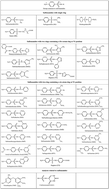Forcing immunoassay for sulfonamides to higher sensitivity and broader detection spectrum by site heterologous hapten inducing affinity improvement
Abstract
Three immunizing haptens, 6-(4-aminophenylsulfonamido)hexanoic acid (HS), 4-(4-(4-aminophenylsulfonamido)phenylsulfonamido)benzoic acid (SSS) and 4-(4-(4-aminophenylsulfonamido)phenyl)butanoic acid (SA10), were synthesized and used as haptens to produce generic polyclonal antibodies against sulfonamides. A novel generic enzyme-linked immunosorbent immunoassay (ELISA) for the detection of sulfonamides was developed based on one site heterologous coating hapten derived from sulfadiazine (STZ), providing IC50 values below 100 ng mL−1 for the 26 sulfonamides tested in buffer. The study showed that the site heterologous coating hapten could significantly improve the sensitivity of ELISA in comparison to a homologous or bridge length heterologous coating hapten. The developed ELISA was used first for the detection of five sulfonamides in spiked chicken muscle with recovery values ranging from 80.9 to 87.4% when the clean-up step was not included and from 85.6% to 92.7% when the clean-up step was included in sample pretreatment. The study showed that the high sensitivity and broad specificity of the assay make it a suitable screening method for the determination of multi-sulfonamides residues in chicken muscle.


 Please wait while we load your content...
Please wait while we load your content...